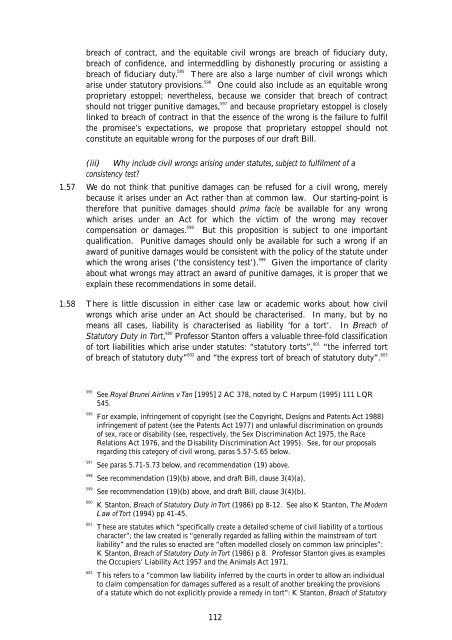Aggravated, Exemplary and Restitutionary ... - Law Commission
Aggravated, Exemplary and Restitutionary ... - Law Commission
Aggravated, Exemplary and Restitutionary ... - Law Commission
You also want an ePaper? Increase the reach of your titles
YUMPU automatically turns print PDFs into web optimized ePapers that Google loves.
each of contract, <strong>and</strong> the equitable civil wrongs are breach of fiduciary duty,<br />
breach of confidence, <strong>and</strong> intermeddling by dishonestly procuring or assisting a<br />
breach of fiduciary duty. 595<br />
There are also a large number of civil wrongs which<br />
arise under statutory provisions. 596<br />
One could also include as an equitable wrong<br />
proprietary estoppel; nevertheless, because we consider that breach of contract<br />
should not trigger punitive damages, 597<br />
<strong>and</strong> because proprietary estoppel is closely<br />
linked to breach of contract in that the essence of the wrong is the failure to fulfil<br />
the promisee’s expectations, we propose that proprietary estoppel should not<br />
constitute an equitable wrong for the purposes of our draft Bill.<br />
(iii) Why include civil wrongs arising under statutes, subject to fulfilment of a<br />
consistency test?<br />
1.57 We do not think that punitive damages can be refused for a civil wrong, merely<br />
because it arises under an Act rather than at common law. Our starting-point is<br />
therefore that punitive damages should prima facie be available for any wrong<br />
which arises under an Act for which the victim of the wrong may recover<br />
compensation or damages. 598<br />
But this proposition is subject to one important<br />
qualification. Punitive damages should only be available for such a wrong if an<br />
award of punitive damages would be consistent with the policy of the statute under<br />
which the wrong arises (‘the consistency test’). 599<br />
Given the importance of clarity<br />
about what wrongs may attract an award of punitive damages, it is proper that we<br />
explain these recommendations in some detail.<br />
1.58 There is little discussion in either case law or academic works about how civil<br />
wrongs which arise under an Act should be characterised. In many, but by no<br />
means all cases, liability is characterised as liability ‘for a tort’. In Breach of<br />
Statutory Duty in Tort, 600<br />
Professor Stanton offers a valuable three-fold classification<br />
of tort liabilities which arise under statutes: “statutory torts”, 601<br />
“the inferred tort<br />
of breach of statutory duty” 602<br />
<strong>and</strong> “the express tort of breach of statutory duty”. 603<br />
595 See Royal Brunei Airlines v Tan [1995] 2 AC 378, noted by C Harpum (1995) 111 LQR<br />
545.<br />
596 For example, infringement of copyright (see the Copyright, Designs <strong>and</strong> Patents Act 1988)<br />
infringement of patent (see the Patents Act 1977) <strong>and</strong> unlawful discrimination on grounds<br />
of sex, race or disability (see, respectively, the Sex Discrimination Act 1975, the Race<br />
Relations Act 1976, <strong>and</strong> the Disability Discrimination Act 1995). See, for our proposals<br />
regarding this category of civil wrong, paras 5.57-5.65 below.<br />
597 See paras 5.71-5.73 below, <strong>and</strong> recommendation (19) above.<br />
598 See recommendation (19)(b) above, <strong>and</strong> draft Bill, clause 3(4)(a).<br />
599 See recommendation (19)(b) above, <strong>and</strong> draft Bill, clause 3(4)(b).<br />
600 K Stanton, Breach of Statutory Duty in Tort (1986) pp 8-12. See also K Stanton, The Modern<br />
<strong>Law</strong> of Tort (1994) pp 41-45.<br />
601 These are statutes which “specifically create a detailed scheme of civil liability of a tortious<br />
character”; the law created is “generally regarded as falling within the mainstream of tort<br />
liability” <strong>and</strong> the rules so enacted are “often modelled closely on common law principles”:<br />
K Stanton, Breach of Statutory Duty in Tort (1986) p 8. Professor Stanton gives as examples<br />
the Occupiers’ Liability Act 1957 <strong>and</strong> the Animals Act 1971.<br />
602 This refers to a “common law liability inferred by the courts in order to allow an individual<br />
to claim compensation for damages suffered as a result of another breaking the provisions<br />
of a statute which do not explicitly provide a remedy in tort”: K Stanton, Breach of Statutory<br />
112
















